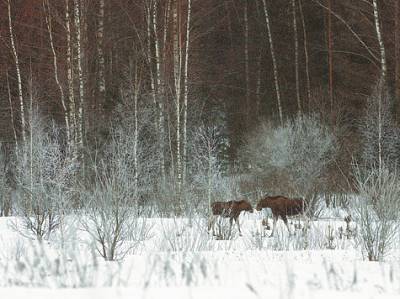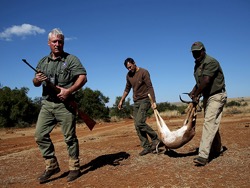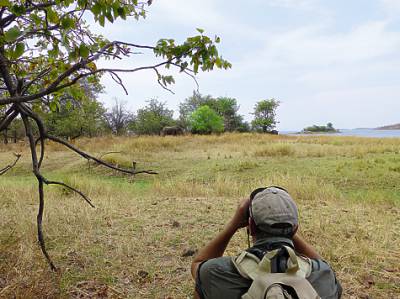
On pictures from space it is evident that throughout the African continent dominated by desert and evergreen rain forest, between which stretches a wild, erratic, and beautiful Savannah is an extensive area covered with grass and scattered trees.
Savannah is sepertinya space, characterized by a sublime tropical countries with dry continental climate. In contrast to these steppes (as well as the North American Prairie) savanna, in addition to herbs that contain shrubs and trees, sometimes growing dense. Herbaceous vegetation of savannas consists of tall (0.5–1 m tall) dry and zhestkokrylykh grain, growing commonly a turf; the grasses mixed with other perennial herbs and shrubs and in moist areas, flooded in the spring, the representatives of the family Cyperaceae. Savannah the trees are commonly stunted, not above our fruit trees, which are very similar on their crooked stems and branches.
Main features of all components of the natural environment of the savannas are defined by a sharp alternation of dry and wet periods. In the rainy season flows of water in rivers increase in 15-20 times, which dramatically increases runoff, actively carried out slope or plane wash. Flowering trees and shrubs are usually in the late dry or early rainy season, fruits in rains. In the dry season the water content of rivers is dramatically reduced, small streams of water dry up, lowering of the groundwater level, actively manifested processes of weathering. Vegetation of plants slows or stops, many trees shed their leaves. Some animals make significant transitions in search of water and food, while others hibernate. We can say that grass is the main character in Savannah, the absence or presence of the seasons determines the presence or the temporary absence of many species of animals.
The total area of the African savannas is comparable to the size of Australia. It is believed that they occurred 5-7 million years ago when the climate became dry and tropical rain forests began to disappear.
Modern African Savannah exist largely at the expense of credo-forming activities of large ungulates and elephants. Ungulates, eating grass and fresh shoots of woody vegetation, prevent overgrowth, elephants are thinned shrubs and break is not too large trees to get to the juicy shoots. With the advent of the savannas of the individual began to play the so-called pyrogenic factor — regular burning of dry vegetation that, on the one hand, prevents the reforestation of savannas, and in some countries leads to their transformation into deserts.
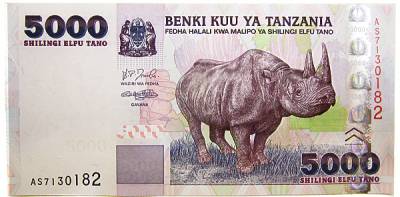
On banknotes of many African countries presents the fauna of the Black
continent.
In January 2012, four friends-zoologists, visited the well-preserved areas of the Savannah in two countries in East Africa — in Kenya and Tanzania. The total length of avtomarket was 2400 km. And it is without internal trips to nature reserves and national parks. In total we visited ten of the most interesting natural areas. In Kenya, this reserve “Samburu” national Park “Lake Nakuru”, a unique freshwater lake Naivasha, the Masai Mara national Park (biosphere reserve) Amboseli. In Tanzania, we visited Olduvai gorge, the biosphere reserve of the Ngorongoro conservation area and three national parks: Serengeti, Tarangire and Lake Manyara.
In the North of Serengeti national Park, an area of about 15 000 km2, bordered placed in Kenya with the Masai Mara, which, in essence, is an extension of the Park. And in the South-East of the Serengeti is protected natural area — biosphere reserve of the Ngorongoro conservation area. Together with him and other valuable adjacent territories formed a biosphere reserve with an area of approximately 23 000 km2.
One of the features of the Serengeti is the migration of ungulates. Annually in the dry season of October and November, more than a million wildebeest and about 220,000 zebras move from the Northern hills to the southern plains, where at this time are the short tropical rains. Then in April — June the animals migrate to the West and North. During this long annual journey, they are 3000 km away. scientists estimate that this entire gigantic biomass requires 4,000 tons of grass each day.
For centuries the vast wasteland of the Serengeti plains were not settled, лишь100 years ago the nomadic Maasai came from the North along with their livestock. The first European that came here in 1891, was a German Explorer and naturalist Dr. Oscar Baumann.
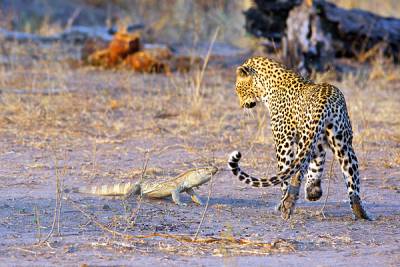
A rare shot: a young leopard was faced with Nile monitor lizard.
In 1921, the Serengeti appeared partial reserve with an area of 3.2 km2, and in 1929 — a full sanctuary, which by 1951, as there was a growing recognition that wildlife must be protected, expanded and turned into a national Park. However, the British colonial government of the then Tanganyika has reduced its size by 1/3, and the entire ecosystem there is a bigger threat.
In the steppes of the Serengeti grazing over a million large animals, but their huge herds constantly move from one place to another. The picture changes all the time: the wildebeest fill the steppe to the horizon, then disappear somewhere, and for several months the steppe is like dying. There have been many different assumptions (insolvent) as to where these animals come, and whither goest. They were offered new, more narrow boundaries of the Park. However, no one has found a way to trace next mass migration of these animals. During the rainy season, even in a jeep you can’t drive on the few roads that there are, and only through the flooded plains, through the mountains and canyons and does not get.
In the late 1950s, the famous German zoologist Bernhard Grzimek, Professor, Director of the Frankfurt zoo, along with his son Michael conducted a unique study to determine ways the annual ungulate migrations, to prove the need for the protection of much larger areas. About this job Grzimek made a documentary “Serengeti shall not die” (Serengeti shall not die!), who was awarded the Berlin “the Golden bear” and later the “Oscar” and with great success was shown in 63 countries.
In the rainy season, which lasts from November to may, the herds of wildebeest, zebras and other herbivores migrate in search of fresh pastures in the Masai Mara. And during the dry season of the Northern short grass plains become almost a semi-desert, causing mass migration of herbivores in the field of tall grass steppes, where there was lush vegetation. After the rains begin again, the herds head back. Grimeca studies have convincingly shown that the area of specially protected natural territories (SPNT) not only cannot be reduced, but on the contrary, should be expanded to protect large animals throughout their life cycle.
***
In February / March 2015 we visited another African country — Cameroon, where the protection of nature in General, as the entire system of national parks, much worse than in Western and southern Africa. Besides the fact that Cameroon is a poor and economically underdeveloped country, on its territory from the North, from Nigeria, regularly invade the gang of terrorists “Boko-Haram”, and armed gangs of poachers from the Central African Republic, hunting for the tusks of forest elephants. A significant portion of the country occupied by tropical forests, and to protect them is harder than Savannah, where a group of Rangers from afar you can’t see the poachers and prosecute them. Tourists from Europe and America there are few.

WHITE HUNTERS AGAINST POACHERS.
Trophy hunting of Africa belongs to an elite hobby, and the cost of such occupation license, equipment, weapons — hundreds of thousands of dollars. Funds received by the state from the sale of licenses for trophy hunting are directed to the reproduction of animal populations and their support in the wild.
Except the owners of hunting concessions, active role in the fight against poaching is played by international organizations that support trophy hunting, such as National Wildlife Federation, The Wilderness Society and
The Wildlife Society. They are the main sponsors of the fight against poaching.
Unfortunately, in East Africa outside the national parks the situation in recent years has deteriorated dramatically. Today, this region became the epicenter of the poaching of elephants. In June last year, the government of Tanzania reported that over the past five years the country has lost 60% of its elephants and their total number dropped from 110 to 44 thousand. Neighboring Mozambique during the same period has lost about 48 % of the elephant population. The poor residents of these countries to kill elephants to get money, virtually no risk. Even if they get caught, the punishment will be minor.
With regard to Central Africa, poaching is another underlying reason. Militants and terrorists will use the proceeds from the sale of illegal ivory funds to Finance paramilitary gangs. Bandits kidnap people, force the prisoners to engage in poaching, as Rangers and Rangers are just killing.
Illegal hunting of elephants in Africa is happening now in the Sudan. So, in 2012 about one hundred horse poachers from Sudan (among them were immigrants from Chad) invaded the territory of the national Park Buba nudge in Cameroon, quietly broke camp and more than a month killed 650 elephants. Common in the Sudan unimpeded supply of arms in exchange for ivory suggest that gangs of poachers are “protected” by the Sudanese government. Although the Sudan has become a stronghold of the ivory traders, but it is not among the major States of poachers. The Convention on international trade species of wild fauna and flora threatened of extinction (CITES), highlights eight of the participating countries “poaching concern”: China, Vietnam, Kenya, Malaysia, the Philippines, Thailand, Uganda, and Tanzania. Vietnam in recent years as a result of rising incomes and the emergence of the middle class has become along with China the biggest market for ivory Oriental medicine. The main flow of illegal tusks loaded on the ships in the ports of East Africa in Dar-es-Salaam, Zanzibar, Mombasa and Beira and then through the Philippines (the main transshipment node) in the countries of South-East Asia.

